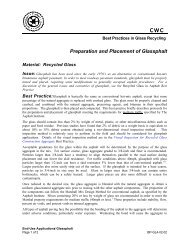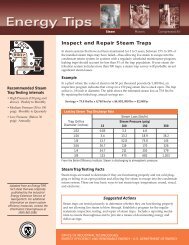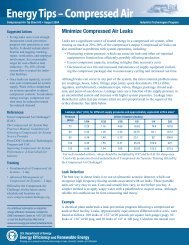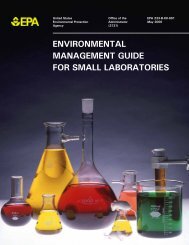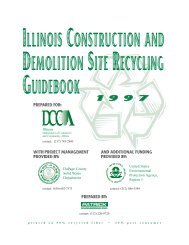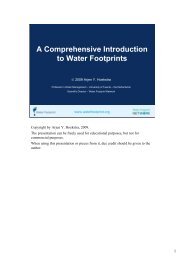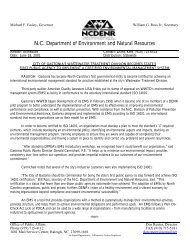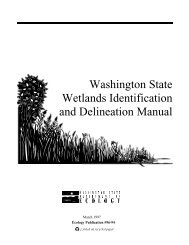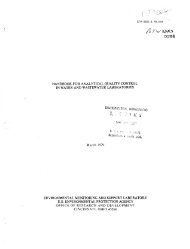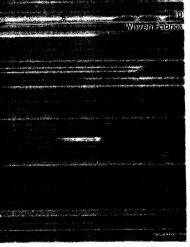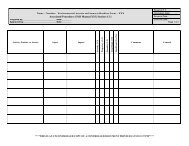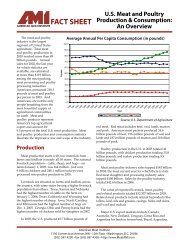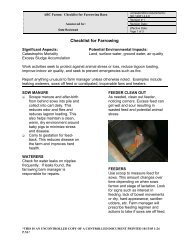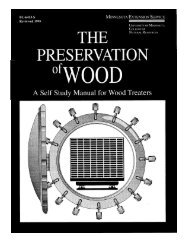Implementing Safer Alternatives to Lithographic Cleanup Solvents to ...
Implementing Safer Alternatives to Lithographic Cleanup Solvents to ...
Implementing Safer Alternatives to Lithographic Cleanup Solvents to ...
Create successful ePaper yourself
Turn your PDF publications into a flip-book with our unique Google optimized e-Paper software.
Downloaded By: [UOEH - Journal of Occupational and Environmental Hygiene] At: 20:17 10 February 2009Printers, Unions, EmployersHowever, reaping the public health benefits of healthprotectivealternatives <strong>to</strong> populations outside the reach ofThere was interest in implementing safer alternatives amongprinters and their union representatives, who were concerned aregulation remains a significant challenge. A large studyabout the health impacts of solvent exposure, and employers of pollution prevention activities in the hospital industrywho had an a priori commitment <strong>to</strong> a “Green Business” model. concluded that legal standards remain important incentives forHowever, the in-depth evaluation required <strong>to</strong> investigate and hospitals <strong>to</strong> reduce or eliminate hazards. (38) A crucial strategycompare the health hazards of new cleanup products was for implementing safer lithographic cleanup products will bereported <strong>to</strong> exceed the time or technical expertise of printers <strong>to</strong> bring regulations in other air districts up <strong>to</strong> the standards ofin small shops; the vast majority of lithographic printing the SCAQMD. The opportunity <strong>to</strong> address these challengesfacilities are small facilities with fewer than 20 employees. (34) exists. Strong, ongoing support for fostering the linkagesA program of education, outreach, and technical support would between environmental and occupational health was foundbe expected <strong>to</strong> give printers and employers the <strong>to</strong>ols they need among representatives of local, state, and federal governmental<strong>to</strong> overcome these barriers.agencies with environmental health-related mandates and whoshared a vision and in-depth knowledge of the pollutionpreventionapproach.Supply ChainA more formidable barrier <strong>to</strong> implementing safer cleanupproducts was that printing press and high-VOC cleanup LIMITATIONSproduct manufacturers and vendors, who play a central roleTin printer decision making, did not promote or provide informationabout alternatives. As a result, printers had <strong>to</strong> be suffi-hese findings stem from a small convenience sample ofprinters and shops, and therefore, the degree <strong>to</strong> whichciently motivated <strong>to</strong> go outside their established supply chainthey are representative of the use of cleanup solvents inrelationships <strong>to</strong> seek less hazardous products. The effort andother lithographic print shops is not known. The descriptivethe nature of established relationships with vendors, includingfindings regarding the lithographic cleanup work process arefriendships and perks, appeared <strong>to</strong> be strong disincentives <strong>to</strong>consistent with other published reports. The high-VOC cleanupimplementing alternatives.solvents identified in this investigation have been documentedin use industrywide. (1,39) Data from three print shops in thisinvestigation estimated the duration of a printer’s use ofChemical Hazard Informationcleanup solvents <strong>to</strong> be in the range of 30 <strong>to</strong> 120 min per day;This small case study is illustrative of the systemic shortcomingsof MSDSs (35) and the lack of sufficient publicly 48 and 180 min per 12-hour shift. (7) The observation of poorother reports are in the range of 90 min a day, (22) and betweenavailable information about the <strong>to</strong>xicological properties of the ventilation in small shops and less than universal use of glovesvast majority of chemicals in commercial circulation. MSDSs identified in this project have been reported in studies of otherfor 7 of 34 (20.5%) <strong>to</strong>tal cleanup products assessed in this lithographic print shops. (39,40)project lacked essential information such as CAS numbers The findings regarding the support for change among theor concentration data for one or more chemical constituents. employers and printers reflected in this investigation is unlikelyNotably, given the potential for printer dermal exposure, the <strong>to</strong> be representative of the industry overall. Participation<strong>to</strong>xicity from skin contact of the very promising solvent was subject <strong>to</strong> strong selection bias for union printers andalternative, fatty acid esters has not been fully characterized. (36)Green Business employers with an a priori interest in health.In general, California printers may also be more aware ofLinkages Between Occupational and Environmental environmental issues compared with printers in other localesHealthdue <strong>to</strong> California’s more stringent environmental regulations.Because occupational health considerations were incorporatedat the start of the research and development on creases in hazardous printer inhalation exposure. However,We did not collect air moni<strong>to</strong>ring data <strong>to</strong> document de-alternatives, chemicals that could have met the environmental the water-based and soy products are very low vapor pressurecriterion (i.e., solvents such as methylene chloride that are cleaners. The airborne concentrations of these mixtures wouldVOC exempt) but would have introduced serious worker be substantially lower than the airborne concentrations of thehazards were eliminated from consideration as substitutes. currently used cleaners. When ace<strong>to</strong>ne is used, it is generallyLeveraging environmental regulations <strong>to</strong> benefit workers also combined with a lower vapor pressure material that reducescircumvented some of the inadequacies of the current occupationalhealth regula<strong>to</strong>ry apparatus. Current occupational ace<strong>to</strong>ne formulations are higher than the concentrations of theits high volatility. Even if the airborne concentrations of thehealth regulations do not adequately protect printers from currently used cleaners, ace<strong>to</strong>ne is lower in <strong>to</strong>xicity than nearlytheir solvent exposure. For example, printer respira<strong>to</strong>ry and all other organic solvents.neurological symp<strong>to</strong>ms have been documented at air levels far The backdrop <strong>to</strong> this project is the transformation of thebelow legal limits, (5) and regulations permit printers exposed domestic newspaper and other segments of the lithographic<strong>to</strong> methylene chloride <strong>to</strong> incur a risk of 3.6 cancers for every printing industry; these fac<strong>to</strong>rs were not explored by this1000 exposed workers. (37) project and may be relevant <strong>to</strong> the implementation of saferJournal of Occupational and Environmental Hygiene March 2009 185



